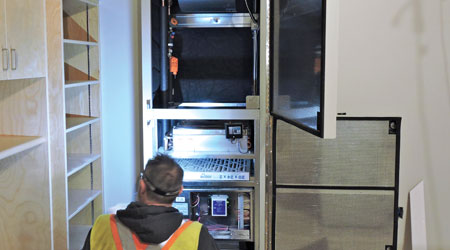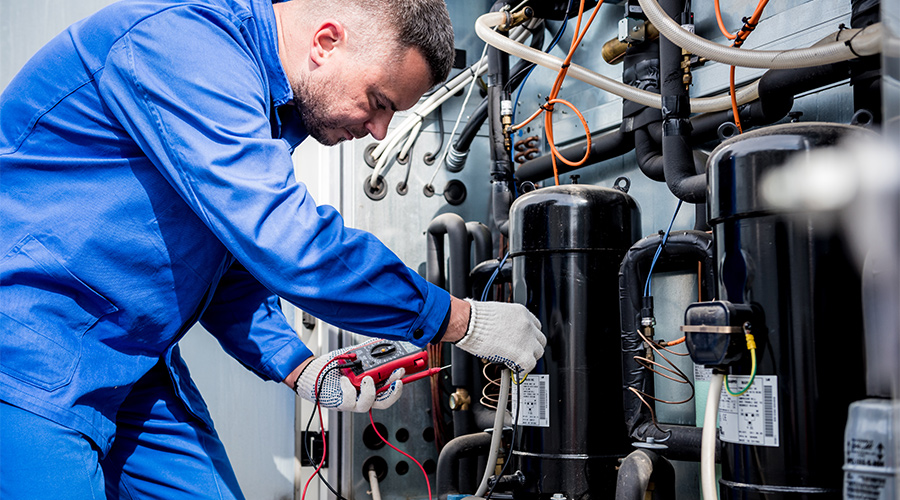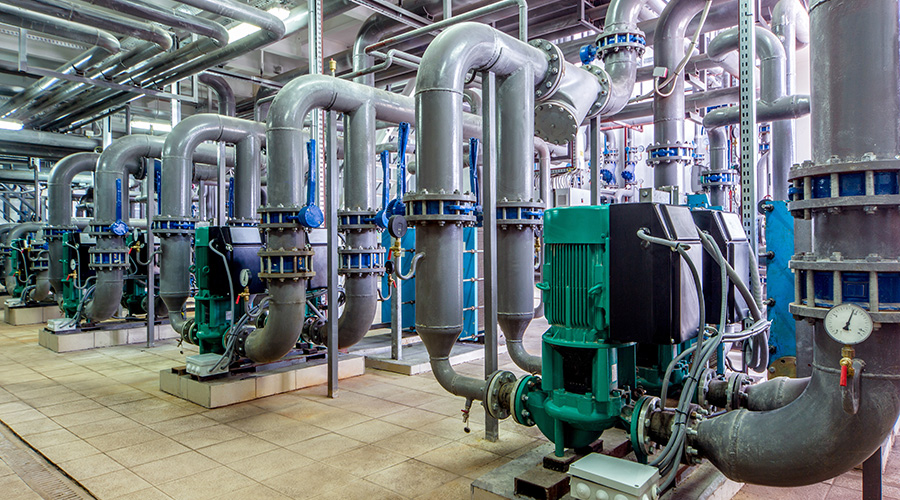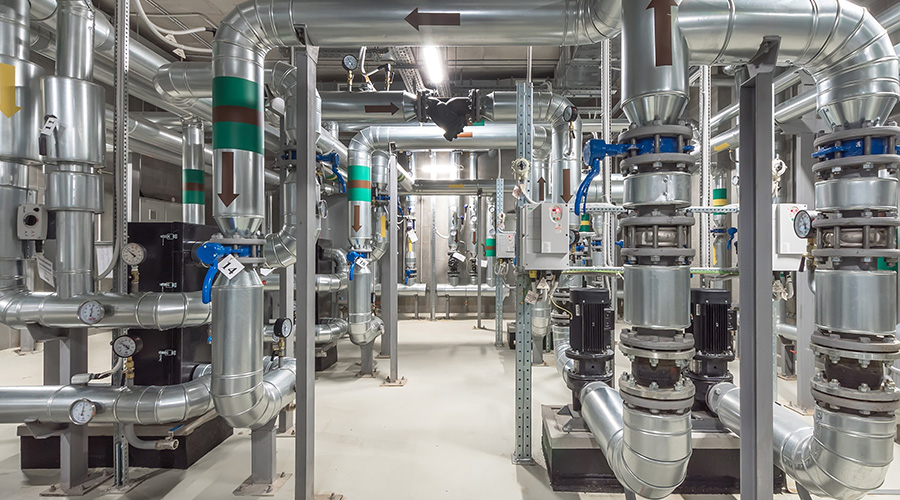5 Steps to Upgrade HVAC Filtration
Here are five best practices to reduce HVAC maintenance, improve indoor air quality, and provide several other HVAC-related benefits.
Upgrading filtration may be the most cost-effective way to clean up indoor air or contaminated outdoor air, but operators must examine the following costs in making decisions:
- Cost of consumables – higher MERV filters are more expensive
- Cost of increased maintenance – higher MERV filters need more frequent replacement
- Cost of equipment upgrades – higher MERV filters may distress existing equipment
The following steps are recommended more or less from least expensive options to most expensive. Keep in mind that indoor air quality (IAQ) budgets have to be reasonable based on the nature and severity of the problem.
Step 1: Assess your current filtration equipment and maintenance programs. Filtration of air is an ancillary function of most modern HVAC systems, and although upgrading to higher efficiency filters may be a cost-effective option, a detailed investigation of existing equipment and operation should be undertaken. Operators should first check to see if simply revising protocols and procedures might achieve their goals. Existing equipment and filter grades may be found to be adequate with complementary strategies such as: altering control options for longer occupied fan run times, including occupied pre and post-purge building air flushes and filtration fan runs; increasing the frequency of filter changes along with duct cleaning, checking and adjusting filter fit and sealing tightness to prevent bypass.
Step 2: Is it possible to upgrade filters in existing equipment and achieve better performance with no other changes needed? In other words, can installed equipment handle higher grade filters without modification? When making assessments, keep in mind the complementary strategies listed above in Step 1. All filters cause restriction in airflow. Higher efficiency filters of the same type add more restriction as the MERV rating increases. This requires careful evaluation during the upgrade selection process because an excessive increase in static pressure can cause damage to some air handling equipment and degrade heating and cooling performance. It is important not to assume higher MERV is always better. Higher MERV filters will increase the initial pressure drop, and they will load-up with dust and particles faster than the less efficient filters did, requiring more frequent filter changes.
When contemplating any filter upgrade or change to equipment, operators should obtain as much detail about the existing equipment and operational specifications as possible. Ideally, there will be Test Adjust Balancing (TAB) records from the original Commissioning Agent and additional reports from any subsequent adjustments and modifications. These records will be invaluable going forward, as they will assist in determining what extra capacity might be available with the existing equipment and will give designers a base-line of performance to work from. Engage a qualified TAB technician to spot check the system to ensure the current performance matches the historic TAB information. Have them re-check and balance the system after changes have been made to ensure the modifications made were compatible with the equipment and operation has not been degraded.
Keep in mind that a change in filter type may avoid static pressure issues. Changing from a flat panel filter to a pleated filter for instance, might allow you to increase MERV without adding a significant static pressure penalty. Partial loading can actually increase the efficiency of a filter, however careful monitoring of filter pressure drop should be a part of any maintenance program. A higher level of scrutiny should be put into play whenever filters are upgraded. Maintenance staff should be supplied with test equipment and trained to measure the progressive pressure drop across upgraded filters. Digital manometers or low-pressure gauges can be used to help establish new replacement schedules. Higher-end air handling equipment may already have filter monitoring devices installed, making it easy for detecting the need for a filter change by on-site personnel or via a building management system. This solution is highly recommended to help prevent wear and tear on equipment, indicate when an unusual situation has created an unexpected blockage, or help avoid the expense of unnecessary filter changes.
Step 3: Is it possible to upgrade existing equipment to accept higher grade filters? Existing equipment may present airflow limitations, but there can be relatively inexpensive ways to make modifications. It is often possible to increase fan speeds to overcome higher static pressures and deliver the same airflow, provided the fan motor can handle the extra electrical load. Consult with equipment manufacturers or I&O manuals to see if this is a viable option.
Filter racks can often be altered or replaced to accept lower pressure drop formats. In general, upgrading to a deeper pleated filter will give you a higher MERV without a large pressure drop penalty. Commercial equipment often comes standard with 2-inch filter racks. If a 2-inch pleated filter is too restrictive it may be a simple matter to upgrade the filter rack to accept a 4- or even 6-inch filter. Consult with an air filter specialist or commercial filter manufacturer or supplier to see what options are available. There could be an alternate filter format available that will work with your equipment. For larger buildings or multiple projects it would be wise to hire a mechanical engineering consultant to help with evaluating existing equipment and coming up with practical solutions.
Step 4: Adding equipment may be required if existing equipment can’t solve the IAQ problems. Many stand-alone “air scrubber” devices have been developed and brought to market due to the recent air quality calamities. They are intended to provide air cleaning solutions mostly for individual rooms, but some can be connected to central systems to add enhanced filtration. Popular formats include: Stand-alone units that are freestanding (fixed or moveable), ceiling mounted, duct mounted, duct bypass, closet or alcove installed, and many more. Typically, these units use a very high (MERV 13 to HEPA) air filter and integral fan. Operating noise complaints are common, but high-quality units intended for classroom and office use will be equipped with acoustic linings, quiet ECM fans and sophisticated controls. Scrutinize manufacturer’s literature for decibel ranges and levels.
Air filtration is a proven way to reduce pathogen concentration and dwell time, but will not in and of itself kill pathogens. There are many air scrubber units available that add UV-C light disinfection and/or bi-polar ionization chambers to the HEPA filter, but caution is warranted. Air and surface disinfection using UV-C germicidal light has been used for years and is recommended by ASHRAE and the U.S. Centers for Disease Control and Prevention (CDC) if applied correctly. CDC has not recommended either for or against bi-polar ionization, but the technology is known to be effective in the right applications. These units should carry certification under the UL 2998 “Standard for zero ozone emissions from air cleaners.” Consumers are urged to do their homework when considering these devices, and should request performance data from multiple sources in order to make a valid assessment.
Step 5: New equipment. Equipment replacement and system re-design as well as purchasing equipment for new facilities, allows building owners to address filtration requirements with fewer compromises. Commercial air handling units are normally highly customizable and can be ordered with many enhanced filtration options with air moving components that will handle the extra loads that may result. Rather than filtration being an afterthought, equipment can be designed from the ground up with options like bigger filter racks, prefilters, variable speed fans to respond to filter loading, control options to monitor pressure drop, airflow sensors, duct design or redesign for better recirculation and building flush — there are many possibilities. Again, consulting with a team of the mechanical engineer, IAQ professional, filtration specialist and equipment manufacturers will help come up with effective solutions and likely save money in the long run. The team needs to keep your budget firmly in mind. In some cases, when all is said and done, they may come up with the most cost-effective solution of all and advise you to simply open the windows from time-to-time.
This article is an excerpt from the e-book, “How to Improve IAQ With Effective Air Filtration.” The entire e-book can be read with a membership to FMD’s premium content product, fnPrime.
Roy Collver has more than 40 years of experience in the HVAC industry. He specializes in hydronics, with a tight focus on boiler technology, controls, and gas combustion. In addition to writing and training, he works in construction administration for mechanical engineering firms.
Related Topics:












